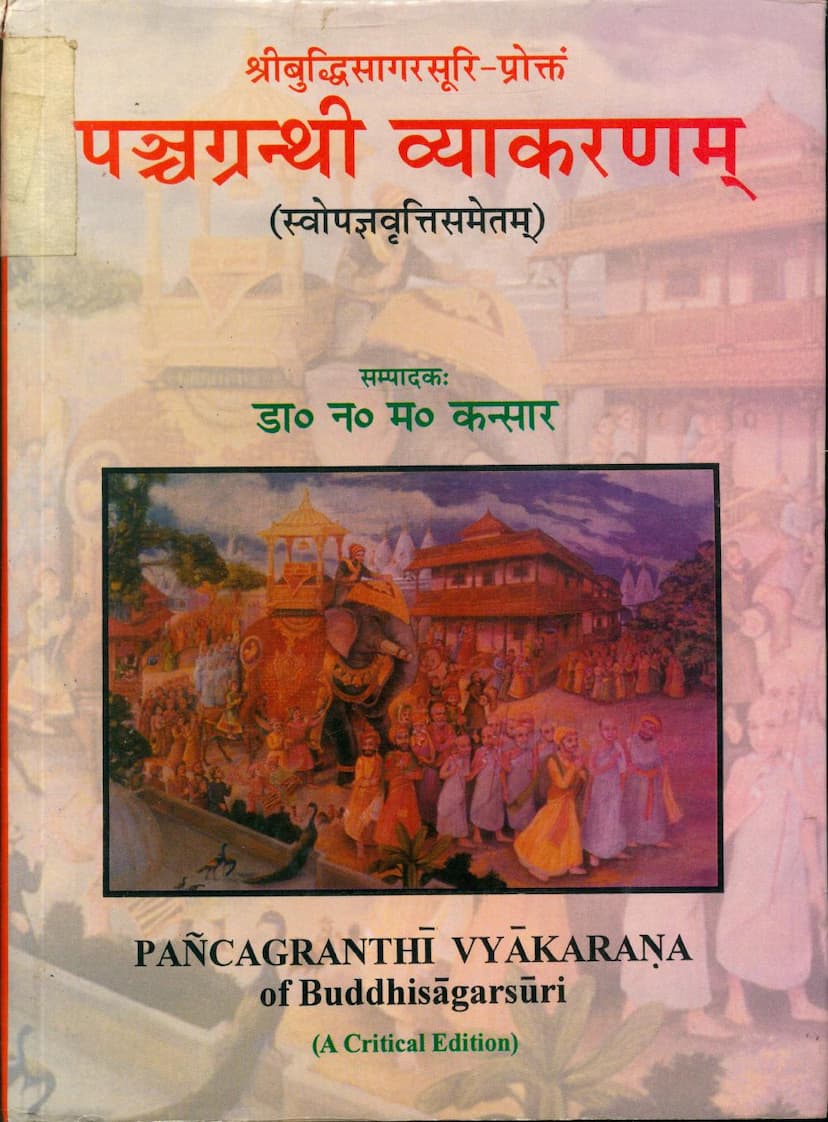Panchgranthi Vyakaranam
Added to library: September 2, 2025

Summary
This comprehensive summary focuses on the Jain text "Pancgranthi Vyakaranam" by N M Kansara, based on the provided information.
Book Title: Panchgranthi Vyakaranam Author(s): N M Kansara (Editor), Buddhisagar Suri (Author) Publisher: B L Institute of Indology Publication Year: 2005 ISBN: 81-208-2950-6
I. Overview and Significance:
- "Pancgranthi Vyakaranam" is a significant metrical grammar of Classical Sanskrit, composed by the celebrated Jain Acharya Buddhisagara Suri (981-1025 A.D.).
- Its title, "Pancgranthi," signifies its comprehensive nature, treating all five essential aspects of Sanskrit grammar:
- Dhatupatha: Lexicon of verbal roots.
- Ganapatha: Lists of word groups.
- Unadipatha: Rules for deriving nominal bases.
- Linganusasana: Treatise on grammatical gender.
- Vyakaranasutras: The main grammatical rules.
- This work is notable for being the first compact, comprehensive, and complete metrical grammar of Classical Sanskrit, integrating these five aspects into a single, verse-based system. This metrical composition was likely intended to aid memorization, a tradition in Indian grammatical studies.
- Chronologically, Buddhisagara's grammar precedes the more famous work of Hemacandra (c. 1140 A.D.), making it an important precursor in Jain grammatical literature.
- The text remained unpublished until 2005 due to its unique style, peculiar structural disposition, and the inadequacy of available manuscripts for earlier critical editing.
- This published work is a critical edition, meticulously edited by Dr. N. M. Kansara, utilizing four manuscripts, the oldest dating back to the 13th century CE.
II. Content and Structure:
- The extant text covers the Sanskrit Adhikara, concluding at the end of the second Pada of the fourth Adhyaya. Each Adhyaya consists of four Padas, with the last one being only half complete.
- The Linganusasana is found within the auto-commentary of a sutra (1.2.1.1).
- The Ganapatha is scattered across various Padas of different Adhyayas, incorporated within the auto-commentary verses.
- The Dhatupatha is located in the auto-commentary on a sutra (3.4.2.1), comprising 131 verses enumerating verbal roots without their meanings (which are elaborated in the prose auto-commentary).
- The Unadipatha is located in the auto-commentary of a sutra (4.1.3.4), consisting of 46 verses.
- The main rules of grammar are presented in metrical verses.
- The work is divided into Adhyayas and Padas, though the author seems to have indicated the end of only the first two Adhyayas and the thirteenth Pada. The author's intention to treat Prakrit language is mentioned but not found in the extant text.
- The total primary verses are 207, fitting 1,922 sutras. The auto-commentary explains, elaborates, supplements, and discusses these verses.
- The work begins with a Mangala-sloka paying respect to Jina and the author's preceptor, declaring the work as "Sabdalakshma" for beginners.
III. Author and Context:
- Acharya Buddhisagara Suri lived between 981-1025 A.D.
- He was a Jain Acharya, likely from the Svetambara tradition, as suggested by the author's lineage and the focus on filling a gap in Svetambara literature.
- He is said to have consulted previous grammatical works by Panini, Candra, Jainendra, Vamana, and Durga before composing his grammar.
- His work is seen as a response to taunts that the Svetambara Jains lacked their own comprehensive grammar, with Jainendra and Sakatayana being earlier Jain grammarians, but from Digambara and Yapaniya traditions respectively.
- Buddhisagara's grammar is considered more important as it predates Hemacandra's well-known grammar and is the first metrical grammar of its kind.
IV. Critical Edition and Sources:
- The critical edition by Dr. N. M. Kansara is based on four manuscripts (one palm-leaf, three paper).
- The editor highlights the corruption and variations in later manuscripts, prioritizing significant and selected readings.
- The study of the Siva-sutras (Pratyahara-sutras) from Panini, Candra, Jainendra, and Sakatayana reveals Buddhisagara's indebtedness to these predecessors.
- Buddhisagara's grammar shows striking similarities with the Sakatayana-vyakarana, particularly in incorporating auxiliary texts within the auto-commentary and the metrical form.
- His Dhatupatha is entirely in metrical form, a unique feature compared to predecessors.
- Buddhisagara's works are influenced by Panini, particularly the Kasika-vrtti of Vamana-Jayaditya, and also draws from Candra and Jainendra grammars. He also consulted Vamana's Visrantavidyadhara-vyakarana and Durga's Vrtti on Katantra for his Linganusasana.
V. Unique Features:
- Metrical Composition: The entire grammar, including the main rules and the auxiliary texts (Dhatupatha, Ganapatha, Unadipatha, Linganusasana), is composed in verses of various metres, making it a unique work.
- Integration of Five Aspects: Unlike separate treatises by earlier grammarians, Buddhisagara integrated all five aspects into a single, cohesive metrical work.
- Jain Grammatical Tradition: It stands as a significant contribution to the Jain grammatical tradition, particularly for the Svetambara Jains, providing a comprehensive grammar of their own.
In essence, "Pancgranthi Vyakaranam" by Buddhisagara Suri, as critically edited by N. M. Kansara, is a groundbreaking work in Sanskrit grammar, distinguished by its metrical format, comprehensive coverage of grammatical aspects, and its pivotal position within the Jain scholarly tradition.